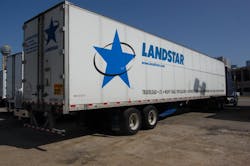So this study got a lot of folks talking last month: about small motor carriers and the often unacknowledged outsized role they perform in trucking, even as many predict their extinction; about whether true freight visibility is possible if so much freight is outsourced; and whether this is yet another indication that more positive collaboration is needed between shippers and motor carriers in order to track and protect cargo more effectively.
I also got an interesting call from Joe Beacom, vice president and chief safety officer at Landstar System; one of the carriers mentioned prominently in the LaneAxis study, which concluded Landstar outsourced over 76% of its freight.
Beacom wanted to explain that the term “outsourcing” got misconstrued when applied to Landstar, largely because his company’s fleet is comprised of nearly 10,000 “business capacity owners” or BCOs to start with: owner-operators that haul freight solely for Landstar.
In Beacom’s view, “outsourcing” isn’t an afterthought in Landstar’s case: it is at the heart of the company’s business model – a deliberate strategy designed to attract the best and most experienced truck drivers around.
Landstar’s BCOs “are better drivers, are safer drivers, and maintain a good record of compliance,” he explained to me. “These are guys who own their own business and who don’t want to go out of business. So they are bringing a very different – and higher – level of service and performance to the customer.”
The average age of Landstar’s BCO population is around 51, as they tend to be older drivers, Beacom added – but that also means they are more seasoned, safer and more savvy; just the kind of truck driver most fleets want.
And it seems that it’s a business model that resonates with the drivers, too, as Landstar’s turnover rate is right around 25%, way below the 100% average in the TL sector.
Beacom noted that Landstar does use outside carriers to haul the roughly 50% of freight its BCOs can’t handle, but they are 10 truck or less-sized fleets that sport “the same approach” to the business that Landstar’s BCOs do.
Is his philosophy working? Well, the numbers sure seem to back it up. Despite the sluggish freight environment that’s been dogging the trucking industry of late, Landstar keeps turning a sizable profit – for its shareholders and its BCOs.In the first quarter, the carrier booked total revenue of $712 million and reported gross profits of $112.2 million, with an operating margin of 42.7% – with its BCOs hauling 92% of all that freight revenue, or just over $655.1 million.
"During the 2016 first quarter, the number of loads hauled via truck was higher than any first quarter in Landstar history. Given the freight environment during the quarter, where demand was somewhat softer than during the 2015 first quarter, I am pleased with the continued execution of adding increased volumes," noted Jim Gattoni, Landstar's president and CEO, back in April when the company released its earnings statement.
Though revenues were 7% below what Landstar achieved in the first quarter of 2015, he stressed that was “entirely due” to a 10% lower revenue per load, particularly on loads hauled via truck.” Yet the number of loads went up 3% when the two quarters were compared: up 4% for dry vans, up 1% for “unsided/platform” equipment (mostly flatbeds), and 3% for LTL shipments.
So despite a market suddenly plagued by excess truck capacity, more pricing pressure from shippers, and a fairly gloomy outlook for freight volumes for the rest of 2016, Landstar’s BCOs keep rolling and keep making money.
Just goes to show a certain old saying applies to trucking on occasion – it’s never the size of the dog in the fight that matters; it’s the size of the fight in the dog.

